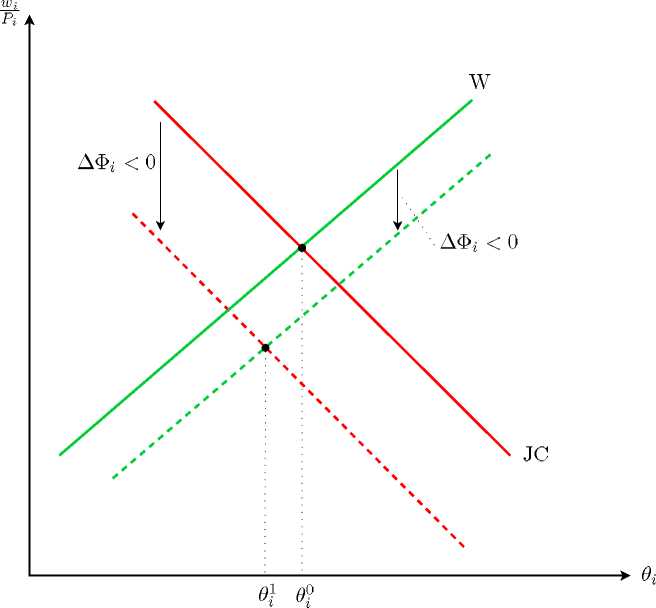curve (Wi) down by less than the job creation curve (JCi) . It follows that both the real
wage and the degree of labor market tightness fall.

Figure 1: The effect of a fall in Φi on labor market tightness.
Part (d) establishes that, whatever the equilibrium value of Φi turns out to be, changes
in the most relevant labor market institutions - the replacement rate bi, hiring costs ci,
and the efficiency of the matching process mi - have similar qualitative effects on labor
market tightness and, hence, on the rate of unemployment.13 We will see below that the
determination of Φi does not directly depend on labor market institutions bi, ci, or mi but
only on labor market outcomes such as the real wage or the rate of unemployment. It
follows that changes in bi, ci, or mi have all qualitatively similar effects on labor market
outcomes in all countries. In our comparative statics exercise, it is therefore sensible
to focus on bi as one important (and empirically relevant) representative institutional
variable.
2.3 Entry- and Export Decisions of Firms
In this section, we need to set up those conditions that pin down Φi for all countries. This
is done by combining two sets of equations: conditions that describe the selection of firms
into different markets (the domestic and foreign ones) according to their productivity
13We have ∂θi∕∂bi < 0,∂θi∕∂ci < 0, and ∂θi∕∂mi > 0.
12
More intriguing information
1. Estimating the Technology of Cognitive and Noncognitive Skill Formation2. The name is absent
3. TECHNOLOGY AND REGIONAL DEVELOPMENT: THE CASE OF PATENTS AND FIRM LOCATION IN THE SPANISH MEDICAL INSTRUMENTS INDUSTRY.
4. Categorial Grammar and Discourse
5. Regional science policy and the growth of knowledge megacentres in bioscience clusters
6. The name is absent
7. The name is absent
8. The name is absent
9. The name is absent
10. Demographic Features, Beliefs And Socio-Psychological Impact Of Acne Vulgaris Among Its Sufferers In Two Towns In Nigeria